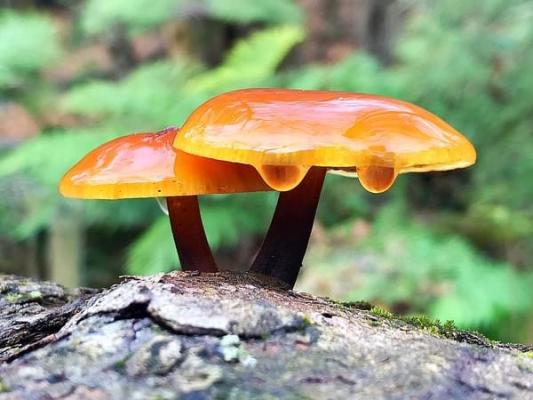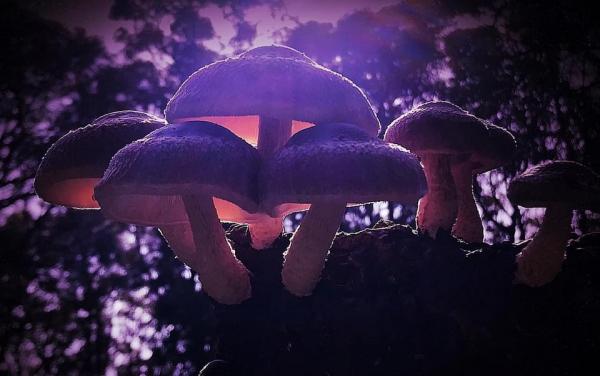By Shelby Brooks
Emerald’s Sibel Kruithof has been busy during Covid-19 lockdowns photographing curious looking fungi. She rediscovered her childhood interest in mushrooms last year and has since become fully immersed in the fungi world and their unique properties.
Born and raised in Germany, Sibel was immersed in foraging practices from a young age.
“Mushrooms have been a big part of my life from the beginning,” she said.
“My mum grew up in the post-war area and she had to go to the forests before school and pick mushrooms to then deliver to customers to make money to pay for groceries for her family.
“When I grew up, my mum would strap me on her back and we’d go into the forest and pick mushrooms.”
But since moving to Australia when she was 24 and raising a family in Emerald, Sibel said she hadn’t found time to explore her passion for mushrooms until the first lockdown last year.
“It got a little bit forgotten until we went into the first lockdown in Victoria and I had a little bit of fine to go to certain areas I hadn’t been,” Sibel said.
“I saw all these mushrooms that I remembered from the time when I was a kid so we started collecting them and I got more and more into finding out more about them.
“After years of creating as an artist becoming quite popular with my business Precious Grain I now feel the time has come to expand again and mushrooms have become my biggest passion in life by far.
“Everything fascinates and captivated me, from the visual aspect to the medicinal properties they provide to the practical and environmental solutions they offer.“
She said a lot of the mushrooms in Europe and Australia are the same.
“There’s a lot of pine forests in Europe and a lot of monoculture and plenty of mushrooms around, the same species that we find here,” Sibel said.
“In Germany, you have mushrooms like saffron milk caps and parasols- a lot of same mushrooms as you can find here.
“Some of them have been brought over with plants, because a lot of mushrooms are mycorrhizal they live together in symbiosis so they were imported to the area or came with immigrants.”
Sibel went on to complete a mushroom cultivation course and is now growing a range of gourmet mushrooms out of her home.
“It kind of completely took over my life from then on,” Sibel said.
“I started growing different varieties, I’m still in the hobby stage at the moment but we are looking for a suitable place to actually extend it to a little mushroom farm business, Mycelium Wisdom, where we can hopefully provide mushrooms to different shops and restaurants.
“At the moment, I am still growing from a grow tent from one of my spare rooms.”
Sibel grows gourmet mushrooms for eating, as well as some medicinal ones.
“The medicinal ones usually aren’t that nice tasting,” she said.
“Reishi mushrooms are highly prized mushrooms in Chinese medicine now western medicine use a lot of those properties which are immune boosting and anti-inflammatory.”
In terms of gourmet mushrooms, Sibel grows oyster mushrooms which are easy and come in multiple varieties.
“If I can grow with the season, I don’t have to cool or heat the fruiting room,” she explained.
“It’s easier to utilise the actual temperature so I’ll grow King oyster mushrooms, lion’s mane and shiitake in cooler times and when it’s warmer, it’s better for reishi, pink and golden oyster.”
Foraging is still something that Sibel is enjoys, though she warns a lot of time is spent learning about mushrooms before going.
“You have to be very careful when you go foraging. A lot of mushrooms might not kill you but make you really sick,” she said.
“You really have to do your research and study to know the ones you can pick.
“There’s only really one mushroom here in Australia that is really poisonous, the night cap one that gets confused with the store-bought field mushrooms
“If you’re not 100 per cent certain, leave it, don’t eat it.”
Sibel said there are techniques to ascertain if a mushroom is safe to eat or not.
“When you cut a mushroom, it will stain a certain way, like a yellow stain usually means no good,” she said.
“Some mushrooms look like a field mushroom but stains yellow and that one will give you sore stomach.”
Sibel said heating a little piece of mushroom can also help identify if they are safe to eat.
“You can also tell from the smell. Heat exposure usually brings out a certain smell like a phenolic, ink smell which means they are no good.”
Sibel has combined her love of photography with her newfound passion for mushrooms by documenting mushrooms she finds and grows.
“Photography has always been a really big part of my life,” Sibel said.
“With mushrooms it’s so much to do with the attention to detail, the magnification of certain aspects of fungi.
“The whole thing has taken me completely in. I love zooming into a mushroom or seeing certain parts and putting it into the foreground and into the spotlight, I just love doing it.”
But it did take a little while for Sibel’s three kids to come around to the idea of consuming so many mushrooms.
“My kids don’t like mushrooms that much, but mine are pretty willing to eat them now,” she said.
“I have put quite a bit of time into finding out recipes to put into meat dishes.
“Some mushrooms that taste almost like the real deal, like king oyster mushrooms are excellent to use as a meat dish.”
Sibel replaces pulled pork with pulled mushroom to make a burger that tastes like the real thing or enchiladas are also a popular mushroom dish in her household.
“There were complaints at the beginning but they’re pretty used to it now,” she said, laughing.
But Sibel believes mushrooms can have even greater environmental benefits than just as a meat replacement.
“Mushrooms are really one of only the lifeforms that could really save this planet,” Sibel said.
“Oyster mushrooms in particular can decompose a nappy in two months instead of it being in landfill for years.
Mycelium from the mushrooms eat plastic.
Earlier this year it was announced that the Federal Government would invest $15 million in grants to support Australian-led research into the use of magic mushrooms and other psychedelics into their use in treating mental illnesses.
Ikea also switched out Styrofoam packaging for mycelian based biodegradable packaging.
“People looking at mushrooms more and more,” Sibel said.
“Mushrooms don’t just taste good but have all these other amazing abilities.”









